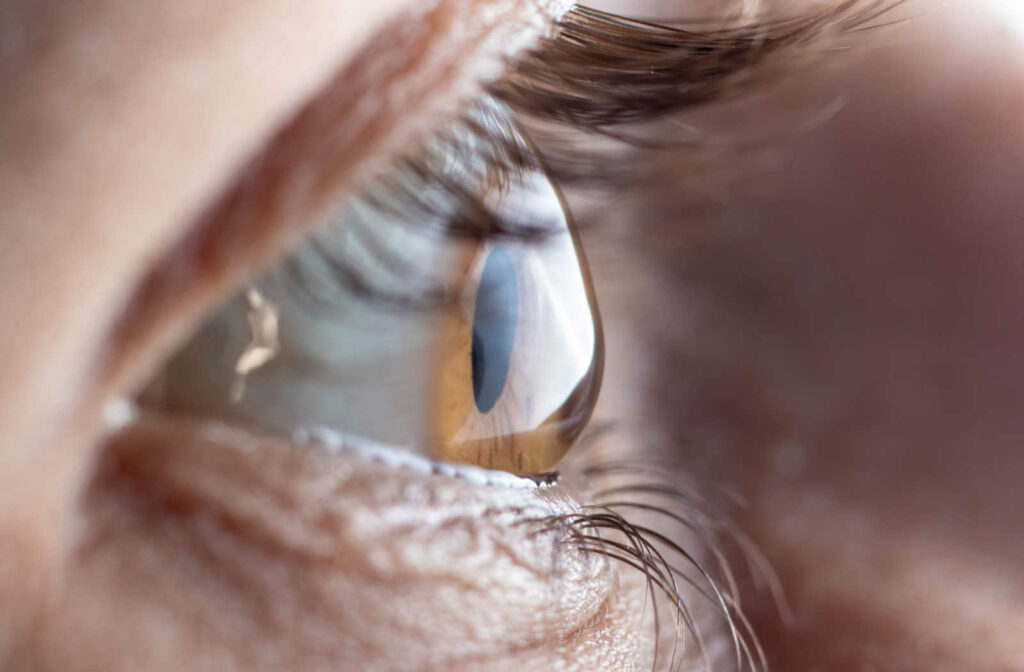If you have ever had an eye examination and received a glasses prescription, you may have been curious about all the numbers recorded on the piece of paper.
For people with astigmatism, you will likely see three numbers written in a form similar to S x C x Axis. This refers to spherical, cylinder, and axis, which are used to determine things like nearsightedness, farsightedness, and the orientation of your astigmatism. It is normal for your eye axis to be different as the shape of your eye and the location of astigmatism can change and are not always the same in each eye.
At Avenue Optometry & Vision Therapy, our experienced doctors and staff are happy to book an eye examination and help you to determine your prescription.
What is an Eye Axis?
The axis of your eye indicates where astigmatism may be present on your cornea. It is written in degrees between 0 and 180, revealing the orientation of where your astigmatism aligns concerning the eye.
How to Measure Your Eye Axis
When checking for astigmatism or other ocular-related issues, your eye axis will typically be measured during an examination by an optometrist or another eye specialist. An eye exam may include tests like keratometry, corneal topography, and a refraction test when looking for astigmatism.
What is a Normal Eye Axis
It is important to note that a higher axis number does not mean you will have a stronger prescription. Instead, the axis number is merely an indication of the position of your astigmatism. That being said, a “normal eye axis” would not have an axis number because you would not have astigmatism.
What is Astigmatism?
Astigmatism is a common eye condition that typically results from an abnormally shaped cornea or lens.
How to Diagnose Astigmatism
Astigmatism can be diagnosed during a routine eye exam using one of the standard tests mentioned below or another that your eye care specialist may prefer.
- Eye Chart: A test asking you to read numbers from a chart at various distances. It is intended to measure visual acuity.
- Photoropter: A binocular-like device that you will look through and read numbers from as the lenses in the device change.
- Autorefractor: A computer-controlled machine that will measure how light changes as it enters through your eyes.
- Keratometer: A medical instrument used to measure the curve of your cornea.
Additionally, children may not be aware that they are having difficulty seeing clearly. It is essential to regularly book them for an eye screening with an eye care specialist if any symptoms become noticeable.

Symptoms of Astigmatism
If you have astigmatism, you may be experiencing some of the following common symptoms:
- Blurry or distorted vision
- Headaches or general discomfort
- Eye strain
- Difficulty seeing at night or having to squint to see clearly
If you notice any of these symptoms, make sure to book an eye exam and have them examined by a professional.
Astigmatism & Other Refractive Issues
It is not unusual for astigmatism to be present alongside other refractive conditions, such as myopia (nearsightedness) and hyperopia (farsightedness).
Treatment for Astigmatism
The typical treatment method for astigmatism is to receive prescriptions, glasses or contact lenses. However, in some cases, your eye care provider may recommend refractive surgery.
Here are a few types of refractive surgeries that can be done to treat astigmatism:
- Laser-assisted In-situ Keratomileusis (LASIK):
- Laser-assisted Subepithelial Keractectomy (LASEK)
- Photorefractive Keratectomy (PRK)
- Small-incision Lenticule Extraction (SMILE)
At Avenue Optometry & Vision Therapy, you can book an eye examination and consultation to discuss the next steps for achieving clearer vision.
How to Read an Eyeglass Prescription
Axis is not the only number that will be provided on your eyeglass prescription, but there are other series of numbers, letters, and names that may appear on the paper. These are the instructions that are used to prepare the lenses for your glasses.
Here are a few of the important acronyms that may be seen on your eyeglass prescription:
- Oculus Sinister (OS): The Latin abbreviation for the “left eye”.
- Oculus Dextrus (OD): The Latin abbreviation for the “right eye”.
- Oculus Uterque (OU): The Latin abbreviation for “both eyes”.
- Spherical (S): Refers to the degree of nearsightedness or farsightedness.
- Cylinder (C): It measures the degree of astigmatism in your eye through diopters.
In your prescription, you will receive a (+) or (-), which refers to whether you have nearsightedness or farsightedness. A plus is being farsighted, and a minus is being nearsighted.
The plus or minus on your prescription will be combined with a number representing the condition’s degree of severity. Generally, the higher the number, the more severe your condition.
Book an Eye Exam
If you’re concerned about your eye axis or wish to speak with a professional, make sure to book an eye exam with our Avenue Optometry & Vision Therapy team today.
Our experienced staff are happy to conduct an assessment and help you to start working towards clear and comfortable vision.




